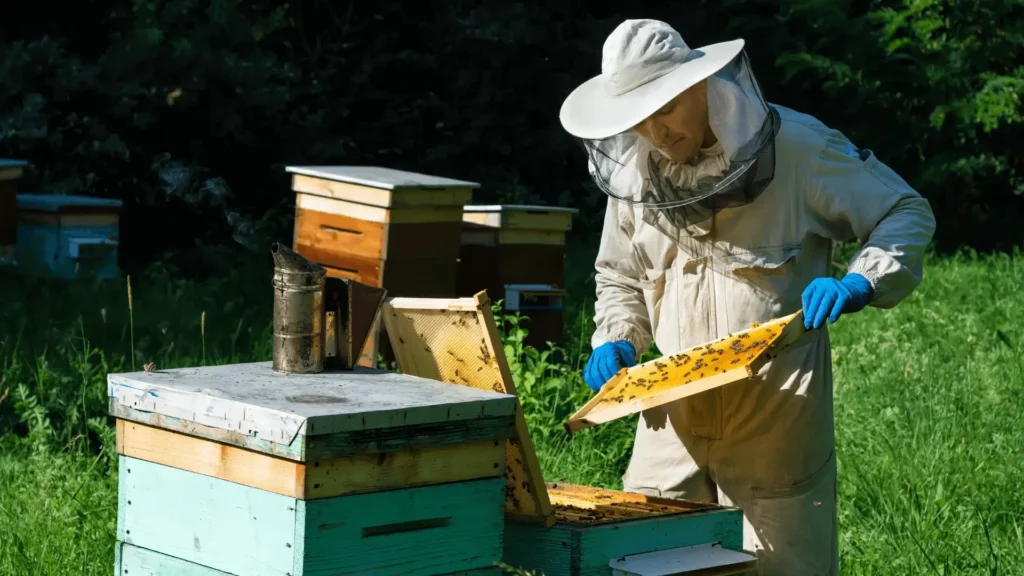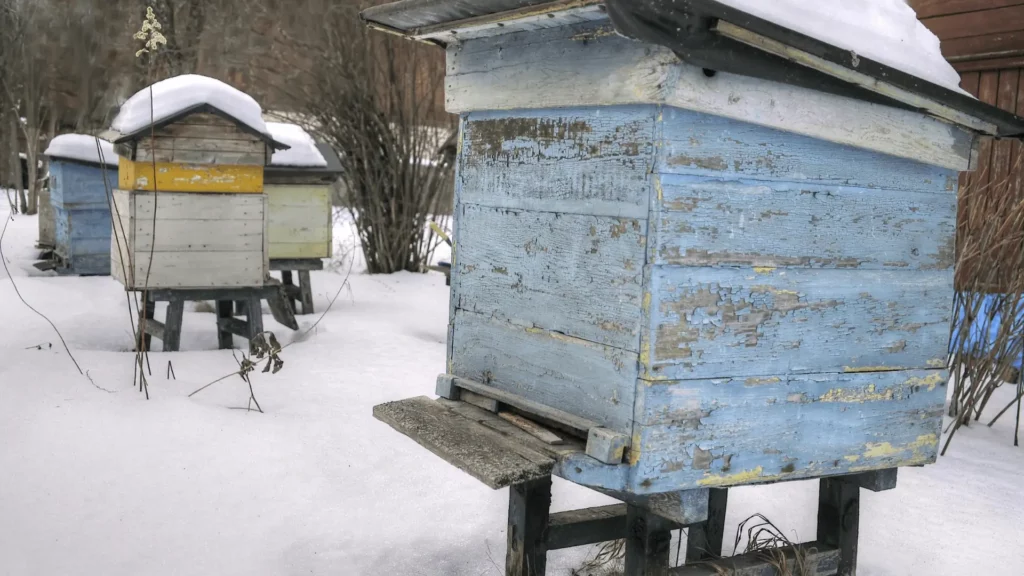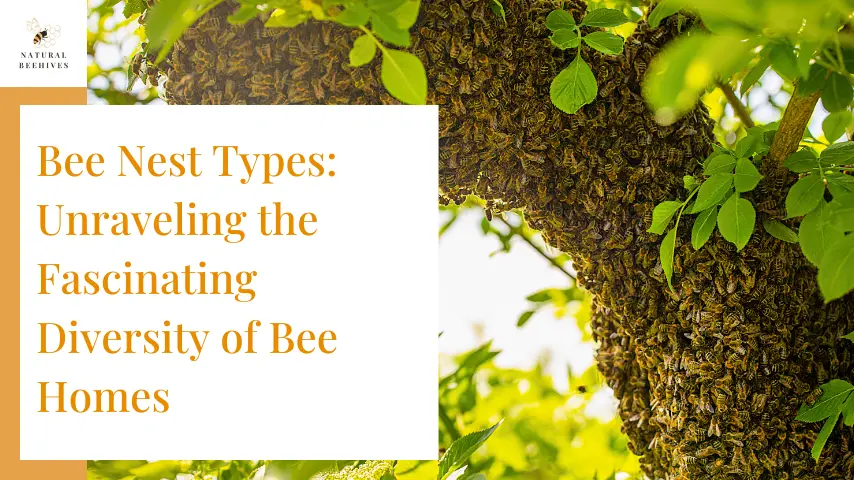
The world of bees is a fascinating one, filled with complex social structures, intricate communication systems, and impressive architectural feats. Within this vast and diverse world, one particular aspect stands out – the types of nests that bees build. These unique structures vary greatly depending on the species, environment, and behavioral patterns of the bees. In this article, we will explore the intriguing world of bee nest types, delving into their characteristics, functions, and significance in the larger ecosystem.
To fully understand the diversity of bee nest types, it is important to first grasp the basic concept of what constitutes a nest. In simple terms, a nest is a structure constructed by bees to provide a safe and suitable environment for their offspring. These nests serve as both a shelter and a place for bees to carry out their various activities. The design and construction of bee nests can range from simple underground burrows to intricate and elaborate structures made of beeswax or other materials.
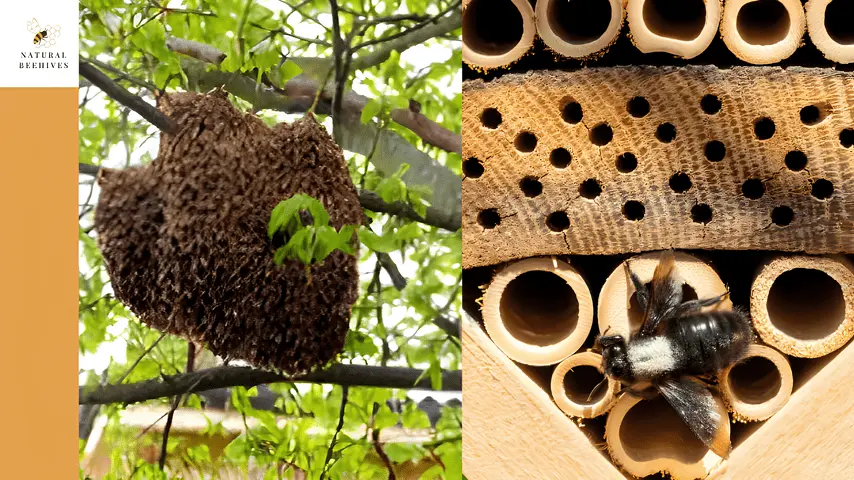
One of the most common types of bee nests is the solitary nest, where individual bees work independently to create and maintain their own nests. Solitary bees can be found in a variety of habitats, from forests to urban environments, and each species has developed unique nesting behaviors tailored to their specific needs.
In contrast, social bees, such as honey bees and bumblebees, build communal nests that house large colonies with distinct roles for worker bees, drones, and a queen. These complex social structures play a crucial role in the survival and reproduction of the colony, with each member contributing to the overall success of the hive.
The diversity of bee nest types reflects the incredible adaptability and resourcefulness of these fascinating insects. By understanding the different types of nests bees build and the purposes they serve, we can gain valuable insights into the intricate world of bees and their vital importance to our environment. Whether living solitary lives or as part of a bustling colony, bees continue to captivate us with their remarkable behaviors and contributions to the natural world.
Types of Bee Nests
1. Ground Nests: Some bee species prefer to build their nests underground, excavating burrows in soil or creating tunnels in soft ground. Ground-nesting bees often choose sandy or well-drained soil for their nests, providing protection for their eggs and larvae from predators and extreme weather conditions.
2. Cavity Nests: Certain bee species utilize existing cavities or hollow spaces to construct their nests. This includes nesting in abandoned burrows, old tree trunks, or even man-made structures such as bee hotels or nesting boxes. Cavity-nesting bees exhibit adaptability in utilizing diverse habitats for their nesting requirements.
3. Wood-Nesting Bees: Bees that nest in wood, known as carpenter bees, create their nests by burrowing into dead wood or plant stems. These bees use their mandibles to excavate nesting galleries, where they construct cells for their developing offspring. Wood-nesting bees play a crucial role in wood decomposition and nutrient recycling processes.
4. Aerial Nests: Some bee species build their nests above ground, attaching them to vegetation, rocks, or human structures. These aerial nests can take the form of hanging clusters of cells or exposed combs. Aerial-nesting bees adapt to open environments, relying on their nest defense strategies to protect their colonies from predators.
5. Wax Nests: Social bees, such as honey bees, construct elaborate nests made of beeswax. These intricate structures are meticulously built by worker bees who produce beeswax from special glands in their bodies. The wax is then molded into hexagonal cells where the bees raise their brood and store honey and pollen. The honeycomb structure of beeswax nests is not only a marvel of engineering but also serves practical purposes in terms of storage, insulation, and efficiency in space utilization.
In addition to the physical characteristics of bee nests, the location and placement of nests also play a critical role in the survival and success of bee colonies. Factors such as proximity to food sources, protection from predators, exposure to sunlight, and access to resources all influence where bees choose to build their nests. Understanding these considerations can offer valuable insights into the behavior and ecology of different bee species.
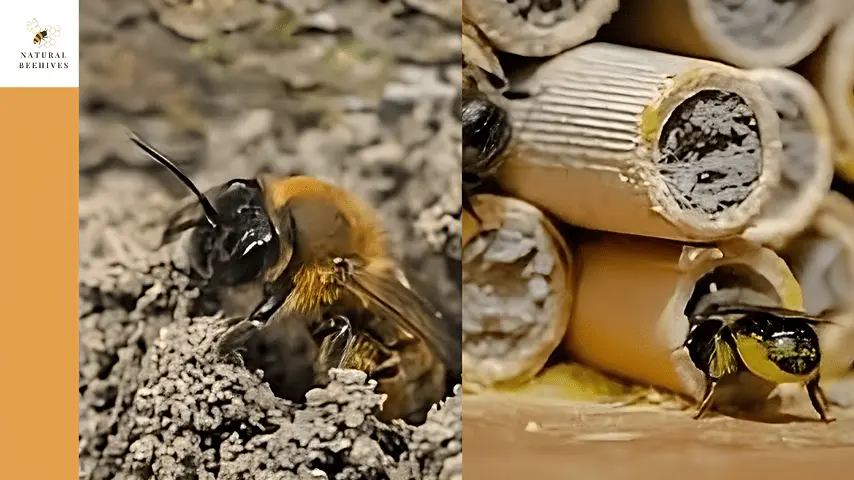
Ground Nests
Ground-nesting bees exhibit fascinating adaptations to their subterranean lifestyle, utilizing various strategies to thrive in their chosen habitats. These bees are adept at excavating tunnels and chambers in the soil, creating a safe and secure environment for their offspring to develop. The choice of soil type is crucial for ground-nesting bees, as well-drained and sandy soils offer stability and protection from moisture, preventing waterlogging that could harm developing larvae.
Some ground-nesting bee species, such as mining bees, construct entrance tunnels that lead to multiple branching burrows where individual cells are provisioned with pollen and nectar for their larvae. These bees demonstrate remarkable precision in their nesting behavior, carefully arranging provisions and sealing off cells to protect their offspring from potential threats.
Ground nests also play a vital role in the ecosystem, contributing to soil aeration and nutrient cycling through the activities of tunneling bees. By understanding the unique adaptations and behaviors of ground-nesting bees, we can appreciate the intricate relationships between these pollinators and the environments they inhabit.
What are Ground-nesting Bee Species?
Ground-nesting bee species encompass a diverse group of bees that have evolved unique adaptations to thrive in their subterranean habitats. These bees exhibit fascinating behaviors and characteristics that distinguish them from other types of bees. Some common examples of ground-nesting bee species are:
1. Mining Bees (Andrenidae): Mining bees are a large family of ground-nesting bees known for their solitary lifestyle and intricate nesting behaviors. These bees typically excavate nests in sandy or well-drained soil, creating elaborate tunnel networks that lead to individual brood cells provisioned with pollen and nectar. Mining bees are important pollinators for a variety of plants and crops.
2. Sweat Bees (Halictidae): Sweat bees are a diverse group of ground-nesting bees known for their attraction to salt and human perspiration. These bees create underground nests in soil, often forming aggregations of individual nests in sandy or clayey substrates. Sweat bees play a crucial role in pollination and are highly efficient foragers.
3. Digger Bees (Anthophoridae): Digger bees, also known as carpenter bees in some regions, are ground-nesting bees that excavate nests in soil or sandy substrates. These bees are important pollinators for various wildflowers and crops. Digger bees exhibit diverse nesting strategies and foraging behaviors, contributing to the biodiversity of ecosystems.
4. Bumblebees (Apidae): Bumblebees are well-known ground-nesting bees that are recognized for their distinctive fuzzy appearance and buzzing flight patterns. These social bees construct nests in various locations, including underground burrows in dry soil or grassy areas. Bumblebees play a vital role in pollination and are particularly effective at sonication, a unique method of releasing pollen from flowers through vibration. Their colonies exhibit complex social structures with queens, workers, and drones working together to ensure the success of the colony.
Next, let’s explore the fascinating world of cavity-nesting bees and their strategies for nesting in diverse habitats.
RELATED: Bee Hive Guide: Types & Maintenance Tips
Cavity Nests
Cavity-nesting bees are known for their resourcefulness in utilizing existing gaps and hollow spaces for their nesting needs. These bees can be found nesting in a variety of locations, from abandoned rodent burrows to natural crevices in trees or rocks. Some cavity-nesting bees have even adapted to build their nests in urban environments, taking advantage of man-made structures like bee hotels or nesting boxes.
One of the key advantages of cavity nesting is the protection it offers to bee offspring. By constructing nests in enclosed spaces, cavity-nesting bees can shield their developing brood from predators and harsh weather conditions. Additionally, the structure of cavities provides a stable environment for bees to rear their young and store food resources.
Certain cavity-nesting bee species exhibit specialized behaviors in nest construction and maintenance. Mason bees, for example, use mud or other materials to partition cells within their nests, creating separate chambers for each egg laid. Leafcutter bees line their nesting cavities with circular pieces of leaves to form protective walls around their brood cells.
The adaptation of cavity nesting allows bees to thrive in diverse habitats and environments, showcasing the remarkable versatility and resilience of these pollinators. By understanding the nesting behaviors of cavity-nesting bees, we gain insight into the intricate ways in which bees interact with their surroundings and adapt to varying ecological conditions.
RELATED: Bee Hive Beetles: Identification, Life Cycle, And Control Methods
What are Cavity-nesting Bee Species?
Types of cavity-nesting bee species include:
1. Mason Bees (Megachilidae): Mason bees are excellent cavity-nesting bees known for their efficient pollination capabilities and unique nesting behaviors. These bees use mud or clay to construct partitions within their nesting cavities, creating individual cells for each egg and food provisions. Mason bees are solitary bees, with females taking the lead in nest-building and offspring care. Their pollination services are essential for various crops and wildflowers.
2. Leafcutter Bees (Megachilidae): Leafcutter bees are cavity-nesting bees recognized for their distinctive nesting habits involving leaf-cutting activities. These bees use circular pieces of leaves to line their nest cavities, effectively creating protective layers around their developing brood. Leafcutter bees are efficient pollinators and play a crucial role in the pollination of plants like alfalfa, blueberries, and alfalfa.
3. Carpenter Bees (Apidae): Carpenter bees, also known as wood-boring bees, are cavity-nesting bees that exhibit intriguing nesting behaviors. These bees tunnel into wood to create their nesting galleries, using their strong mandibles to excavate nesting sites in dead or decaying wood structures. While carpenter bees are beneficial pollinators, their nesting habits can sometimes pose challenges when they target wooden structures in human-built environments.
4. Solitary Bees (Apoidea): Solitary bees encompass a wide range of cavity-nesting species that exhibit diverse nesting behaviors and nesting site preferences. Unlike social bees that live in colonies, solitary bees are independent nesters, with each female responsible for building and provisioning her own nest. Solitary bees can be found nesting in various locations, from abandoned beetle tunnels to hollow plant stems or artificial nesting blocks. These bees are essential pollinators for many plant species and contribute significantly to ecosystem health and biodiversity.
Next, let’s delve into the intriguing characteristics and nesting strategies of another group of bees known as wood-nesting bees.
Wood-Nesting Bees
Wood-nesting bees represent a unique group of pollinators that utilize dead wood or plant stems as nesting sites. These bees demonstrate remarkable adaptations to this specific habitat, with different species exhibiting varying preferences for the type of wood they choose for nesting. From decaying tree trunks to pithy plant stems, wood-nesting bees display a diversity of nesting strategies that reflect their resourcefulness and ecological niche.
One of the notable characteristics of wood-nesting bees is their ability to excavate nesting galleries within wood substrates. By chewing through the wood fibers and creating intricate tunnels, these bees create suitable chambers for their offspring and food storage. Some wood-nesting bee species, such as carpenter bees, are known for their impressive woodworking skills, capable of excavating extensive galleries in structural wood elements.
The choice of nesting material is crucial for wood-nesting bees, as it not only provides a secure environment for brood development but also influences the bees’ interactions with symbiotic microorganisms. Certain wood-nesting bees form associations with fungi or bacteria that help break down wood components, aiding in the digestion of nutrients and enhancing the bees’ overall fitness.
Wood nests play a significant role in nutrient recycling and decomposition processes within forest ecosystems. As wood-nesting bees forage for pollen and nectar, they contribute to plant pollination and seed production, supporting biodiversity and ecosystem functioning.
What are Wood-nesting Bee Species?
Types of wood-nesting bee species include:
1. Carpenter Bees (Xylocopa): Carpenter bees are prominent wood-nesting bee species characterized by their large size and robust appearance. These bees are adept at excavating nesting galleries in wooden structures, such as dead tree trunks or wooden fences. Carpenter bees play a vital role in pollination and are known for their distinctive buzzing sound as they fly from flower to flower.
2. Small Carpenter Bees (Ceratina): Small carpenter bees are diminutive wood-nesting bees that exhibit fascinating nesting behaviors in small diameter twigs or stems. Despite their size, these bees are efficient pollinators and contribute to the reproductive success of various plant species. Small carpenter bees are known for their solitary nature and meticulous nest construction techniques.
3. Yellow-Faced Bees (Hylaeus): Yellow-faced bees are diverse wood-nesting bee species known for their specialized nesting habits in pithy plant stems or pre-existing cavities in wood. These bees are essential pollinators of native flora and are particularly adept at foraging for pollen and nectar in complex floral structures. Yellow-faced bees play a crucial role in maintaining plant diversity and ecosystem stability.
4. Resin Bees (Heriades): Resin bees are distinctive wood-nesting bee species that utilize plant resins in nest construction and brood cell provisioning. Resin bees showcase a unique strategy of collecting plant resins to line their nesting cavities, creating a protective barrier against moisture and potential predators. These resourceful bees play a vital role in pollination and plant propagation, showcasing the intricate interactions between bees and their surrounding environment.
Next, let’s delve into the intriguing characteristics and nesting strategies of another group of bees known as aerial-nesting bees.
RELATED: Bee Swarm vs. Supersedure Cells: Master Queen Cell Management in Your Beehive [Expert Guide]
Aerial Nests
Aerial-nesting bees, as the name suggests, choose elevated locations to build their nests, showcasing yet another fascinating nesting strategy employed by these diverse pollinators. By selecting locations such as tree branches, shrubs, or man-made structures elevated above the ground, aerial-nesting bees exhibit adaptations that differentiate them from ground or cavity-nesting species.
One prominent example of aerial-nesting bees is the well-known carpenter bee, which constructs its nests in wooden structures or tree limbs. Carpenter bees are solitary insects that bore into wood to create nesting tunnels and chambers, demonstrating a remarkable ability to manipulate their environment to suit their nesting requirements.
The elevated placement of aerial nests offers several benefits to bees, including increased protection from ground-dwelling predators and potential flooding during rainy seasons. By choosing aerial locations for their nests, bees can also take advantage of better airflow and sunlight exposure, which may provide optimal conditions for offspring development and food storage.
Additionally, some aerial-nesting bee species exhibit interesting behaviors in nest construction and provisioning. For instance, bumblebee species that nest in above-ground locations such as bird boxes or tree cavities may create intricate wax cells within their nests to house developing larvae and store food reserves.
By understanding the unique adaptations and nesting strategies of aerial-nesting bees, we gain valuable insights into the diversity of behaviors and ecological roles performed by these important pollinators.
What are Aerial-nesting Bee Species?
Aerial-nesting bee species exhibit a wide range of fascinating adaptations and nesting behaviors that allow them to thrive in elevated environments. Some notable aerial-nesting bee species include:
1. Miner Bees (Andrena): Miner bees are efficient pollinators that nest in shallow tunnels excavated in the ground or in sandy soil. Despite their ground-nesting habits, certain species of miner bees also demonstrate aerial nesting behaviors by constructing nests in elevated locations such as rocky outcrops or cliff edges. These versatile bees play a crucial role in pollinating a variety of wildflowers and agricultural crops, contributing to ecosystem health and food production.
2. Mason Bees (Osmia): Mason bees are renowned for their exceptional nest-building skills, utilizing natural materials such as mud or leaf pulp to construct partitioned cells within cavities or crevices. While many mason bee species exhibit ground-nesting behaviors, some members of this diverse group prefer aerial nesting sites such as hollow plant stems or human-made bee hotels. Mason bees are efficient pollinators of fruit trees, berries, and other flowering plants, making them valuable contributors to crop pollination and biodiversity.
3. Leafcutter Bees (Megachile): Leafcutter bees are aptly named for their unique nesting behavior of cutting circular pieces of leaves to construct protective leafy nests for their offspring. Wood-nesting bee species and aerial-nesting bee species represent fascinating examples of the diverse adaptations and nesting strategies employed by different groups of pollinators. By exploring the characteristics and behaviors of these bees, we gain a deeper understanding of their vital roles in ecosystem health and biodiversity.
RELATED: Master Beehive Splitting: 13 Essential Steps for Beekeepers
Wax Nests
Wax-nesting bees, also known as stingless bees or meliponines, are a fascinating group of pollinators that construct elaborate nests using wax secretions produced by specialized glands in their bodies. These bees are commonly found in tropical regions and exhibit highly social behaviors, forming complex colonies with distinct roles for worker bees, drones, and a queen.
The construction of wax nests in stingless bees involves intricate processes of shaping and layering wax to create hexagonal cells for brood rearing, pollen storage, and honey production. The use of wax as a building material provides structural stability to the nest and creates a hygienic environment that helps protect the colony from pathogens and parasites.
Stingless bees rely on their wax nests not only for shelter and food storage but also for regulating temperature and humidity within the colony. The unique properties of wax enable these bees to control the microclimate inside the nest, ensuring optimal conditions for brood development and the preservation of food resources.
One remarkable feature of wax-nesting bees is their ability to recycle and reuse wax in nest construction. As bees emerge from their cells and new generations take over nest maintenance duties, old wax combs are repurposed and integrated into new nest structures, demonstrating a sustainable approach to nest building and resource utilization.
In addition to their role in pollination and honey production, stingless bees play a vital ecological role in tropical ecosystems by contributing to plant diversity and fruit production.
What are Wax-nesting Bee Species?
Several fascinating species of wax-nesting bees exhibit diverse nesting behaviors and social structures that contribute to their unique ecological roles. Some notable examples of wax-nesting bee species include:
1. Bumblebees (Bombus): While bumblebees are widely recognized for their fuzzy appearance and important role as pollinators, certain species within this genus also engage in wax-nesting behaviors. Bumblebee queens establish colonies in abandoned rodent burrows or under dense vegetation, creating wax cells within their nests to rear their young and store provisions. These social insects exhibit complex communication strategies and division of labor among colony members, making them efficient foragers and defenders of their nest.
2. Orchid Bees (Euglossini): Orchid bees are known for their specialized relationships with orchid flowers, as male bees collect floral fragrances to attract mates. Some species of orchid bees construct their nests in tree cavities or hollow stems, utilizing a combination of wax and plant resins to build waterproof cells for their brood. These bees are essential pollinators of orchid plants and other tropical flora, contributing to the diversity and reproduction of flowering plants in their ecosystems.
3. Carpenter Bees (Xylocopa): Carpenter bees are large-bodied pollinators with a reputation for burrowing into wood to create their nests. Carpenter bees exhibit fascinating behaviors related to their nesting habits, as they use their strong mandibles to bore into dead wood or bamboo stems to construct galleries where they rear their offspring. These solitary bees may create multiple chambers within a single nesting site, providing individual cells for eggs, pollen storage, and larval development. Despite their wood-boring activities, carpenter bees are important pollinators for a variety of flowering plants and trees.
4. Mason Bees (Osmia): Mason bees are renowned for their efficient pollination services and intriguing nesting behaviors. These solitary bees use mud, pebbles, or plant resins to construct sturdy partition walls within their nest cavities, creating individual chambers for each egg and food provisions. Mason bees are valuable orchard pollinators, particularly for fruit trees such as apples and cherries, due to their effective foraging abilities and gentle nature.
5. Sweat Bees (Halictidae): Sweat bees encompass a diverse group of bees known for their affinity towards human sweat and nectar feeding. Some species within this family exhibit wax-nesting behaviors, building underground tunnels and cells lined with a waterproof secretion that protects their brood from moisture. Sweat bees are important pollinators for a wide range of wildflowers and agricultural crops, contributing to ecosystem health and plant reproduction.
RELATED: Revolutionize Bee Feeding: 7 Reasons Why the Bucket Bee Raft Is a Game-Changer for Beekeepers
How are Bee Nests Constructed?
Bee nests are constructed with remarkable precision and efficiency, showcasing the sophisticated abilities of these pollinators. The construction process varies depending on the species and nesting behavior, but there are some common elements and techniques used by different types of bees.
1. Bees gather various materials from their surroundings to build their nests. These materials can include mud, pebbles, plant resins, wax, and even saliva which are manipulated to create the desired structure.
2. Bees create individual cells within their nests where they lay eggs and store provisions such as pollen and nectar for their young. These cells are carefully crafted to provide a suitable environment for egg development and larval growth.
3. In some cases, bees use partition walls or dividers within their nest cavities to separate individual cells and create compartments for different purposes. These partitions help in organizing the nest and optimizing space utilization.
4. Bees exhibit unique nesting behaviors based on their species and ecological requirements. Some bees prefer above-ground nesting sites like tree cavities or plant stems, while others opt for underground burrows or tunnels for their nests.
5. Bees continuously maintain and modify their nests to ensure structural integrity and hygiene. They may repair damaged sections, remove debris, and clean the nest environment to create a suitable living space for their offspring.
The video below shows how a bee builds a honeycomb:
What Materials Do Bees Use to Build Nests?
Bees employ a variety of materials in constructing their nests, each suited to their specific nesting behaviors and environmental conditions. Common materials used by bees include:
1. Wax: Bees, particularly those that are wax-nesting species, produce wax from special glands on their bodies. This wax is used to build cells and partitions within their nests, providing a waterproof and protective environment for their eggs and larvae.
2. Mud: Some bees, like mason bees, collect mud to create sturdy walls and partitions in their nests. Mud is a versatile material that can be shaped and dried to form strong barriers within the nest cavities.
3. Plant Resins: Certain bee species gather resin from plants to reinforce their nest structures. Plant resins add strength and durability to the nest walls and help protect the developing brood from external elements.
4. Pebbles: In some cases, bees utilize small pebbles or tiny rocks to strengthen the structure of their nests. These materials are strategically placed to provide stability and support within the nesting chambers.
5. Saliva: Bees may mix their saliva with other materials to create a sticky substance that aids in binding and shaping nest components. Saliva can act as a natural adhesive, helping bees secure various elements of their nests together.
6. Natural Fibers: Certain bee species incorporate natural fibers such as plant fibers or hair into their nest construction.
How Do Bees Choose Nest-Building Materials?
Bees demonstrate remarkable ingenuity in selecting and utilizing materials for their nest-building activities. The choice of materials is influenced by factors such as availability, durability, and functionality within the specific nesting environment. Here are some key aspects of how bees choose nest-building materials:
1. Bees adapt their material choices based on the surrounding landscape and habitat characteristics. For example, bees in arid regions may rely more on mud or resin to compensate for the lack of available plant fibers or wax.
2. Different bee species have evolved unique preferences for specific materials based on their nesting behaviors and requirements. These instincts guide bees in selecting materials that align with their innate nesting instincts.
3. Bees assess the properties of different materials to ensure they meet the structural and protective needs of their nests. For instance, bees choose wax for its waterproofing properties and malleability, while selecting mud for its ability to form solid barriers.
4. Bees adapt their material choices according to seasonal changes and resource availability. During certain times of the year, bees may switch to alternative materials based on their abundance and suitability for nest construction.
5. Some bee species exhibit learning behavior when it comes to nest-building materials. They may experiment with different materials and techniques over generations to optimize nest construction processes and enhance nest durability.
What Are Some Common Materials Used by Cavity-Nesting Bees?
Common materials used by cavity-nesting bees vary depending on their specific ecological needs and nesting preferences. Some of the common materials used by cavity-nesting bees include:
1. Resin: Certain cavity-nesting bees collect resin from plants to seal nest entrances and reinforce nest structures. Resin provides a protective barrier against moisture and predators, enhancing the security of the nest.
2. Leaf Pieces: Some cavity-nesting bees utilize leaf fragments or cut pieces to line their nest cells. These leaf materials serve as insulation and protection for developing larvae, creating a cozy and secure environment within the nest.
3. Propolis: Cavity-nesting bees may also use propolis, a substance made from plant resins, beeswax, and saliva, to seal cracks and crevices in their nests. Propolis has antimicrobial properties that help maintain a hygienic nest environment for the brood.
4. Fibrous Materials: Cavity-nesting bees source fibrous materials such as plant hairs, moss, or wool to create soft linings within their nest cells. These materials offer comfort and insulation for the developing offspring, ensuring their well-being and growth.
5. Silk: Some cavity-nesting bees, like mason bees, produce silk threads to secure nest partitions and create sturdy structures within their nests. Silk provides strength and flexibility, allowing bees to construct intricate nest designs that meet their nesting requirements.
Are All Bee Nests Permanent Structures?
Unlike permanent structures built by humans, bee nests can vary in their permanency depending on the bee species and environmental conditions. Here are some key considerations regarding the permanency of bee nests:
1. Some bee species, particularly solitary bees, construct temporary nests that are used for a single generation or breeding cycle. These nests are usually simple in structure and may not be reused in the following seasons.
2. Certain bee species create semi-permanent nests that can be used for multiple breeding cycles but may require regular maintenance or rebuilding. These nests are often located in natural cavities or pre-existing structures that offer some level of protection and stability.
3. Social bee species, such as honeybees and stingless bees, build permanent nests that can last for several years. These elaborate structures are continuously maintained by the colony and can grow in size as the bee population expands.
4. Bees exhibit remarkable adaptability in responding to changing environmental conditions or threats. Some bee species may modify or relocate their nests in response to disturbances, resource scarcity, or predator pressure, showcasing their ability to adjust nest structures as needed.
5. In seasonal habitats or climates, bees may construct temporary nests during the active breeding season, which are abandoned or repurposed once the season ends. This seasonal approach allows bees to optimize their nesting strategies according to changing environmental cues and resource availability.
How Long Do Bee Nests Typically Last?
Bee nests typically vary in longevity based on factors such as bee species, environmental conditions, and nesting habits. Here are some insights into the typical lifespan of bee nests:
1. Solitary bees that construct temporary nests for a single generation usually exhibit shorter nest lifespans. These nests may last anywhere from a few weeks to a few months, depending on the developmental cycle of the bee offspring and the availability of resources.
2. Semi-permanent nests built by certain bee species can endure for multiple breeding cycles but may require periodic maintenance or rebuilding. These nests may last for a few years under favorable conditions before needing repairs or relocation.
3. Social bee species like honeybees and stingless bees are known for constructing permanent nests that can persist for several years, or even decades, with continuous upkeep by the colony. These nests can evolve in size and complexity over time as the bee population grows and the colony expands.
4. In seasonal habitats, bee nests may have varying lifespans dictated by the cyclical nature of environmental conditions. Nests built during active breeding seasons may only last for a few months before being abandoned or repurposed for subsequent generations.
5. Regardless of the nest type, bees engage in ongoing maintenance activities to ensure the structural integrity and functionality of their nests.
What Factors Determine the Lifespan of a Bee Nest?
Factors such as bee species, environmental conditions, nesting habits, and human interference play crucial roles in determining the lifespan of a bee nest. Here are key factors that influence the longevity of a bee nest:
1. Different bee species have varying nest-building behaviors and material preferences that impact the durability of their nests. Solitary bees, social bees, and cavity-nesting bees each have distinct nest structures and lifespans.
2. The surrounding environment, including weather patterns, availability of nesting resources, and potential hazards, can influence how well a bee nest withstands external pressures. Harsh weather, habitat changes, and pollution can all affect nest longevity.
3. Bees that build permanent nests invest more resources in construction and maintenance, leading to longer-lasting nest structures compared to bees with temporary nests. Nesting habits, such as nest relocation frequency and construction materials, also impact lifespan.
4. Human activities such as habitat destruction, pesticide use, and urban development can disrupt bee nest locations, leading to premature abandonment, destruction, or changes in nest longevity. Conservation efforts and sustainable practices can help protect bee nests from human-induced threats.
Do All Bee Species Live in Colonies or Hives?
While social bee species like honeybees and stingless bees are well-known for living in colonies or hives, not all bee species exhibit this communal behavior. In fact, the vast majority of bee species are solitary, meaning that each individual female bee builds and provisions her own nest without the assistance of other bees. Solitary bees, ranging from mason bees to carpenter bees, play crucial roles in pollination and ecosystem health despite their independent nesting habits. Unlike social bees that live in organized colonies with a division of labor, solitary bees lead more individualistic lives focused on reproduction and survival. This diverse mix of social and solitary bee species contributes to the overall biodiversity and resilience of bee populations worldwide.
What Are the Advantages of Living in a Colony for Bees?
Living in a colony offers several advantages for bees, particularly social bee species like honeybees and stingless bees. Some key benefits of colony living for bees include:
1. In a bee colony, different bees have specific roles and responsibilities based on their age and development stage. This division of labor ensures optimal efficiency in tasks such as foraging, nursing the young, and defending the colony.
2. Bees in a colony work together to share resources such as food, nest maintenance materials, and information about foraging sites. This cooperative behavior helps the colony thrive and adapt to changing conditions.
3. Social bee colonies use collective efforts to regulate the temperature inside the nest, especially crucial for brood development and survival during extreme weather conditions. Bees can generate heat or cool the nest by coordinating their activities.
4. Living in a colony provides bees with greater protection against predators and other threats. Social bees can mobilize a collective defense response to repel intruders and safeguard the nest and its inhabitants.
5. Colony living allows for the production of a large number of offspring, enhancing genetic diversity within the bee population. This diversity can improve the colony’s ability to adapt to environmental changes and challenges.
How Do Hive Bees Differ from Solitary Nesters in Terms of Behavior?
Hive bees, or social bees that live in organized colonies, differ from solitary nesters in several key behavioral aspects:
1. Hive bees exhibit social behavior by living together in large colonies with a structured hierarchy and division of labor, whereas solitary nesters live independently and are responsible for all aspects of nest building, provisioning, and care for offspring on their own.
2. Hive bees have sophisticated communication systems, such as waggle dances and pheromones, to convey information about food sources, nest locations, and potential threats within the colony. Solitary nesters rely on individual exploration and memory to navigate their environment and find resources.
3. In hive bee colonies, different individuals have specialized roles in food collection, processing, and storage. Worker bees gather nectar and pollen, while other individuals perform tasks like honey production and larval feeding. Solitary nesters must personally forage for all resources needed to feed themselves and their offspring.
4. Social bee colonies can mobilize collective defense strategies against predators and intruders, with worker bees cooperating to repel threats and protect the nest. Solitary nesters rely on individual defenses, like stinging behavior, to ward off potential dangers.
5. Hive bees have a queen bee responsible for reproductive activities, while worker bees support her in caring for the brood and maintaining the nest.


